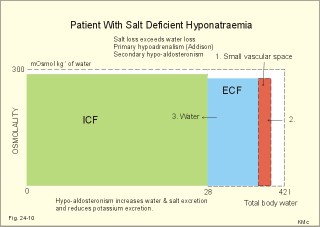
Intracellular and extracellular fluid contains proteins, while the intravascular fluid contains proteins, fats, and blood cells making these fluids mixtures as well as solutions. sodium (Na +), potassium (K +), and chloride (Cl –) ions, solute molecules e.g. The solvent is water, the solutes are numerous and include electrolytes e.g. Fluid within the human body is complex as it is both a solution as well as a mixture at the same time.

Left undisturbed the sand would easily separate from the water and sink to the bottom, whereas the salt remains dissolved. However the water and the sand are not chemically combined and clearly exist as separate substances, i.e. At the shore the sea water disturbs the sand and some of the sand becomes mixed with the water. The two have undergone a reaction and combined in one new substance. The sea water is a solution as it is water (solvent) with salt (solute) dissolved in it. To illustrate this consider the sea and the beach.

To simplify matters, all subsequent calculations will be based on this ‘ideal’ person with a total body water of 45 litres. Total body water (TBW) accounts for 60% of an adult male’s total body weight a normally hydrated 75 kilogram man will consist of approximately 45 litres of water. The amount of water in the body varies with a patient’s age, weight, and sex (Table 1). HOW MUCH FLUID IS THERE IN THE BODY, AND HOW IS IT DISTRIBUTED? If a normally hydrated 75 Kg male patient is kept ‘Nil By Mouth’ for 24 hours, what volume of water would have to be given by alternative routes to maintain hydration, and what electrolytes should the water also contain to replace ongoing losses?.What are the main sources of fluid loss from the body? What volume is lost via these routes in each 24 hour period?.What is the normal osmolality of plasma? How can you estimate plasma osmolality?.What is the volume of extracellular fluid in a healthy 75 Kg male? Where/how is this fluid distributed?.The answers can all be found in the following text. These are for you to test your current knowledge and understanding of body fluid physiology prior to reading this tutorial.

Therefore it is important to have a good understanding of the physiology of normal fluid homeostasis and what happens when these mechanisms fail or are overcome. In a wide variety of illnesses and during surgery, disturbances to this fine balance occur which must be identified and corrected to prevent deterioration, complications and to promote recovery.Ĭare of unwell patients with body water abnormalities and patients undergoing surgery, are encountered daily by medical practitioners. Tight regulation of the balance between water intake and output, and its distribution, is vital to the optimal function of every organ system within the body. When thinking about fluid within the body we are essentially thinking about water.


 0 kommentar(er)
0 kommentar(er)
